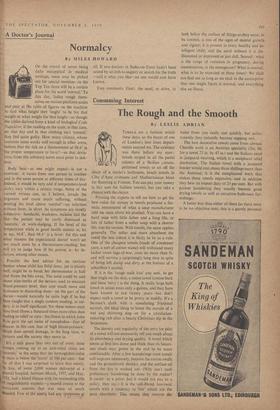A Doctor's Journal
Normalcy
By MILES HOWARD OF the crowd of terms being daily misapplied in medical writings, some may be picked out for special mention—in the Top Ten there will be a certain place for the word 'normal.' To this day, ladies weigh them- selves on station-platform scales and peer. at the table of figures on the machine to find what height they 'ought' to be for that weight or what weight for that height—as though the tables derived from a kind of biological Code Napoleon; if the reading on the scale, at that time, on that day and in that clothing isn't 'normal,' they feel quite guilty. How many citizens, whose common sense works well enough in other areas, believe that the tick on a thermometer at 98.4° is the proper temperature to have?—so that devia- iions from this arbitrary norm must point to sick - x ness.
Body heat—as one might expect—is not a 'constant: it varies from one person to another i,ittid in the same person at different times of day. 4ndeed, it would be very odd if temperature-level flidit't vary within a certain range. Some of the current viruses can, as I believe, invade the 'isurganism and cause much suffering, without 'tending the level above `normal"—an infection ,,,,without fever, in short. As symptoms are mostly Aubjective—headache, weakness, malaise and the like—the patient may be curtly dismissed as 'neurotic,' or work-dodging. If the level of his temperature while in good health centres at, let 4Us say, 96.8°, then 98.4° is a fever; for this and , other reasons the experienced doctor won't set too much store by a thermometer-reading, but ,Will try to judge how ill his patient is—by in- tuition, among other means.
Possibly the best advice for an anxious other whose child has fitful fever, yet is plainly Well, might be to break her thermometer in half `and throw the bits away. The same could be said about nine-tenths of the devices used to measure blood-pressure level; they cost much more and resistance to discarding them—on the part of the doctor—would naturally be qulte high if he has been taught that a single random reading, in sur- eery, is in itself significant. Yet these meters must have bred illness a thousand times more often than leading to relief or cure : the illness to which John : ityle gave the apt name of nosophobia—fear of jsease; in this case, fear of 'high blood-pressure,' iAarhich does untold damage, in the long view, to patients and the society they move in.
It's a safe guess that two out of every three Women coming up to an ante-natal clinic are anaemic,' in the sense that the haemoglobin-value An them is below the 'norm' of 100 per cent.—but fOr all that I was surprised to learn that ninety, no less, of some 3,000 women delivered at a general hospital, between March, 1957, and May, 1958, had a blood disease with the resounding title ‘.6f megaloblastic anaemia—a second cousin to the ,'Pernicious anaemia that was once so much 'dreaded. Few of the ninety had any symptoms at all. if two doctors in Stoke-on-Trent hadn't been seized by an itch-to-inquiry or search for the truth —call it what you like—no one would ever have known.
Two comments. First: the need, or drive, to look below the surface of things-as-they-seem, to be curious, is one of the signs of mental growth and vigour; it is present in every healthy and in- telligent child, and the adult without it is dis- illusioned or depressed or just dull. Second : what is the range of variation in pregnancy, during menstruation, at the menopause? What is normal, what is to be expected at these times? We shall not find out as long as we stick to the assumption that one single figure is normal, and everything else an illness.






































 Previous page
Previous page